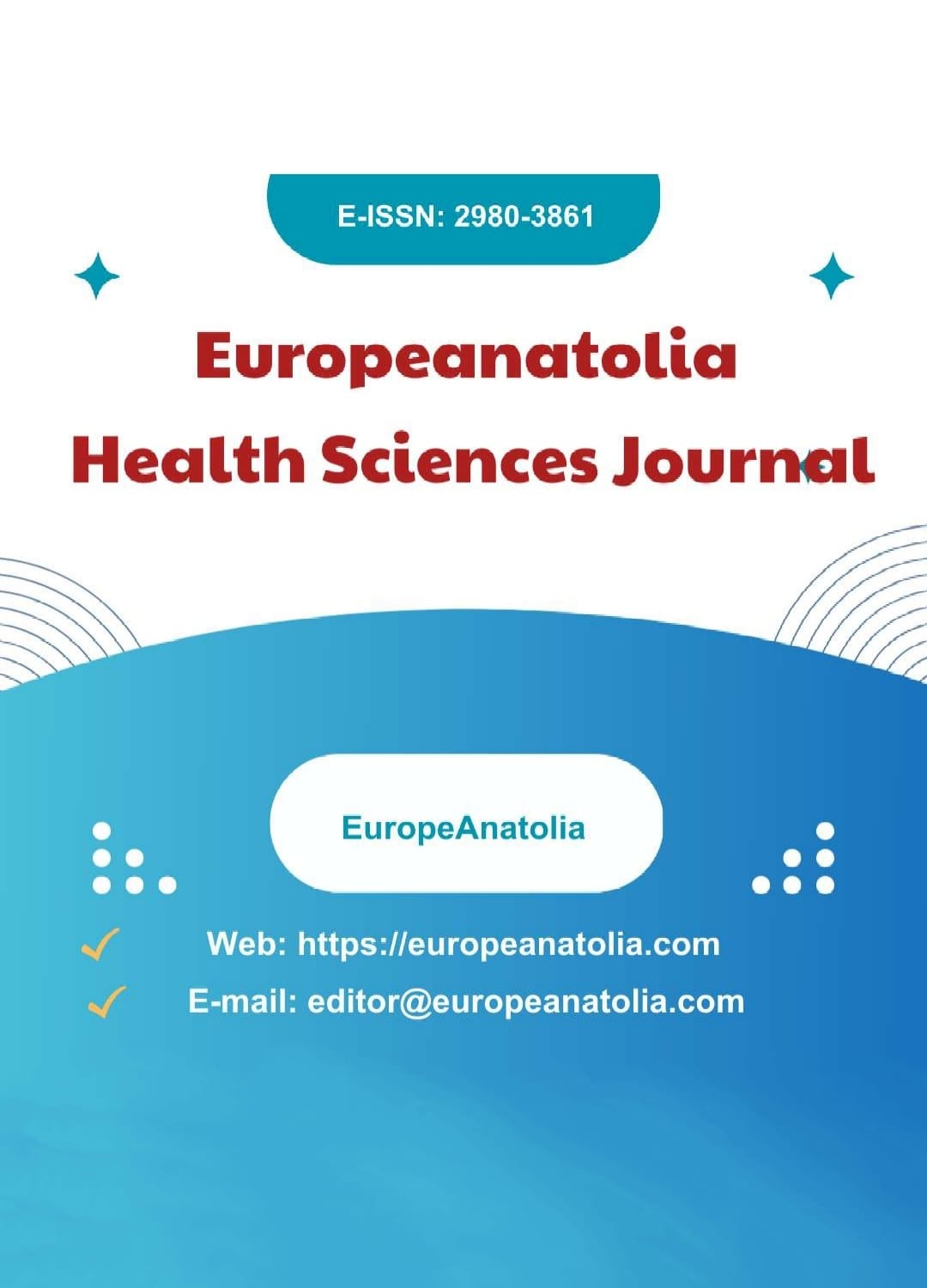Palyatif Bakım Hastalarında Enfeksiyon Yönetimi
Derleme Makale
DOI:
https://doi.org/10.5281/zenodo.10404255Anahtar Kelimeler:
Palyatif Bakım, , Enfeksiyon,, KanserÖzet
Palyatif bakım yaşamı tehdit eden durumlarda hasta ve yakınlarının hayat kalitesini artırmak için yapılan multi disipliner destek tedavilerini kapsamaktadır. Palyatif bakım hastaları eşlik eden hastalıkları, sık hastane yatış öyküleri, immün süpresif durumları ve beslenme yetersizlikleri gibi nedenlere bağlı olarak daha sık enfeksiyonlara yakalanırlar. Palyatif bakım hastalarında enfeksiyonlar başta kanser ve kullanılan ilaçlara bağlı olarak atipik şekilde ortaya çıkabilir. Bu hastalarda enfeksiyonlar uzun hastane yatış süreleri ve sık antibiyotik kullanımı nedeniyle genelde dirençli mikroorganizmalarla oluşur. Palyatif bakım hastalarının kırılgan durumları nedeniyle enfeksiyonlar yüksek morbidite ve mortalite ile seyreder. Palyatif bakım kliniklerinde enfeksiyonlar, uzun hastane yatış süreleri ve artan maliyetler bir kısır döngü şeklinde birbirini artırarak seyreder. Palyatif bakım hastalarında enfeksiyonların yönetiminde hastanın bütüncül bir şekilde değerlendirilmesi gerekir. Hasta özelinde değerlendirme yapılarak tedavinin gecikmeden başlanması morbidite, mortalite ve maliyetleri ciddi oranda azaltacaktır. Bu çalışmanın amacıpalyatif bakım hastalarının enfeksiyon yönetiminde nasıl bir yol izlenmesi gerektiği konusunda öneriler sunmaktır.
Referanslar
World Health Organization.https://www.who.int/news-room/fact-sheets/detail/palliative-care, (Erişim tarihi: 07.06.2023)
Mayo Clinic.https://www.mayoclinic.org/tests-procedures/palliative-care/about/pac-20384637, (Erişim tarihi: 07.06.2023)
Bruera E, Higginson I, von Gunten CF, Morita T. Textbook of Palliative Medicine and Supportive Care, In: Navari RM, Green C, Haney ML, Roach NL. Infection in Palliative Care. Second Edition, CRP Press Taylor&Francis Group, 2015. pp. 789-2.
Nagy-Agren S, Haley H. Management of infections in palliative care patients with advanced cancer. J Pain Symptom Manage. 2002 Jul;24(1):64-70. doi: 10.1016/s0885-3924(02)00420-7. PMID: 12183096.
Mouton CP, Bazaldua OV, Pierce B, Espino DV. Common infections in older adults. Am Fam Physician. 2001 Jan 15;63(2):257-68. PMID: 11201692.
Pereira J, Watanabe S, Wolch G. A retrospective review of the frequency of infections and patterns of antibiotic utilization on a palliative care unit. J Pain Symptom Manage. 1998 Dec;16(6):374-81. doi: 10.1016/s0885-3924(98)00093-1. PMID: 9879162.
Sochor M. Léčba infekcí u pacientů v paliativní symptomatické a terminální fázi onkologického onemocnění [Management of infections in palliative and terminal cancer care]. Klin Onkol. 2013;26(5):323-30. Czech. doi: 10.14735/amko2013323. PMID: 24107154.
Vitetta L, Kenner D, Sali A. Bacterial infections in terminally ill hospice patients. J Pain Symptom Manage. 2000 Nov;20(5):326-34. doi: 10.1016/s0885-3924(00)00189-5. PMID: 11068154.
Dagli O, Tasdemir E, Ulutasdemir N. Palliative care infections and antibiotic cost: a vicious circle. Aging Male. 2020 Jun;23(2):98-105. doi: 10.1080/13685538.2019.1575353. Epub 2019 Mar 1. PMID: 30821574.
Abdel-Karim IA, Sammel RB, Prange MA. Causes of death at autopsy in an inpatient hospice program. J Palliat Med. 2007 Aug;10(4):894-8. doi: 10.1089/jpm.2006.0240. PMID: 17803410.
Homsi J, Walsh D, Panta R, Lagman R, Nelson KA, Longworth DL. Infectious complications of advanced cancer. Support Care Cancer. 2000 Nov;8(6):487-92. doi: 10.1007/s005200000143. PMID: 11094994.
Reinbolt RE, Shenk AM, White PH, Navari RM. Symptomatic treatment of infections in patients with advanced cancer receiving hospice care. J Pain Symptom Manage. 2005 Aug;30(2):175-82. doi: 10.1016/j.jpainsymman.2005.03.006. PMID: 16125033.
Chen LK, Chou YC, Hsu PS, et al. Antibiotic prescription for fever episodes in hospice patients. Support Care Cancer. 2002 Oct;10(7):538-41. doi: 10.1007/s00520-002-0377-9. Epub 2002 Aug 10. PMID: 12324808.
Lam PT, Chan KS, Tse CY, Leung MW. Retrospective analysis of antibiotic use and survival in advanced cancer patients with infections. J Pain Symptom Manage. 2005 Dec;30(6):536-43. doi: 10.1016/j.jpainsymman.2005.06.005. PMID: 16376740.
Mamak T, Hadiseh H, Shirin F, Masoud P, Mohammadreza S, Mahsa A. Antibiotic Treatment in End Stage Cancer Patients; Advantages and Disadvantages. Cancer Inform. 2023 Mar 29;22:11769351231161476. doi: 10.1177/11769351231161476. PMID: 37008074; PMCID: PMC10064464.
Lopez S, Vyas P, Malhotra P, et al. A Retrospective Study Analyzing the Lack of Symptom Benefit With Antimicrobials at the End of Life. Am J Hosp Palliat Care. 2021 Apr;38(4):391-395. doi: 10.1177/1049909120951748. Epub 2020 Aug 24. PMID: 32830525.
Abduh Al-Shaqi M, Alami AH, Zahrani AS, Al-Marshad B, Muammar AB, M Z AS. The pattern of antimicrobial use for palliative care in-patients during the last week of life. Am J Hosp Palliat Care. 2012 Feb;29(1):60-3. doi: 10.1177/1049909111406900. Epub 2011 Jun 15. PMID: 21676985.
Tagashira Y, Kawahara K, Takamatsu A, Honda H. Antimicrobial prescribing in patients with advanced-stage illness in the antimicrobial stewardship era. Infect Control Hosp Epidemiol. 2018 Sep;39(9):1023-1029. doi: 10.1017/ice.2018.167. Epub 2018 Aug 2. PMID: 30070197.
Oh DY, Kim JH, Kim DW, et al. Antibiotic use during the last days of life in cancer patients. Eur J Cancer Care (Engl). 2006 Mar;15(1):74-9. doi: 10.1111/j.1365-2354.2005.00603.x. PMID: 16441680.
White PH, Kuhlenschmidt HL, Vancura BG, Navari RM. Antimicrobial use in patients with advanced cancer receiving hospice care. J Pain Symptom Manage. 2003 May;25(5):438-43. doi: 10.1016/s0885-3924(03)00040-x. PMID: 12727041.
Juthani-Mehta M, Malani PN, Mitchell SL. Antimicrobials at the End of Life: An Opportunity to Improve Palliative Care and Infection Management. JAMA. 2015 Nov 17;314(19):2017-8. doi: 10.1001/jama.2015.13080. PMID: 26426830; PMCID: PMC4675049.
High KP, Bradley SF, Gravenstein S, et al. Infectious Diseases Society of America. Clinical practice guideline for the evaluation of fever and infection in older adult residents of long-term care facilities: 2008 update by the Infectious Diseases Society of America. J Am Geriatr Soc. 2009 Mar;57(3):375-94. doi: 10.1111/j.1532-5415.2009.02175.x. PMID: 19278394; PMCID: PMC7166905.
Liang SY. Sepsis and Other Infectious Disease Emergencies in the Elderly. Emerg Med Clin North Am. 2016 Aug;34(3):501-22. doi: 10.1016/j.emc.2016.04.005. PMID: 27475012; PMCID: PMC5022369.
Crossley, Kent B, and Phillip K. Peterson. Infections in the elderly. Clinical infectious diseases (1996): 209-214.
Özkök S, Cengiz M, Bağ Soytaş R, ve ark. Geriatri Kliniğinde Yatan Hastaların Enfeksiyon Özellikleri. Med Bull Haseki 2020;58:223-227.
Cagatay AA, Tufan F, Hindilerden F, et al. The causes of acute Fever requiring hospitalization in geriatric patients: comparison of infectious and noninfectious etiology. J Aging Res. 2010 Aug 12;2010:380892. doi: 10.4061/2010/380892. PMID: 21151521; PMCID: PMC2989655.
Tal S, Guller V, Gurevich A. Fever of unknown origin in older adults. Clin Geriatr Med. 2007 Aug;23(3):649-68, viii. doi: 10.1016/j.cger.2007.03.004. PMID: 17631239.
Avkan-Oguz V, Yapar N, Erdenizmenli M, et al. Effects of community-acquired infections on fever, leukocyte count and the length of stay in elderly. A cross-sectional study of 240 cases. Saudi Med J. 2006 Mar;27(3):368-72. PMID: 16532099.
Yahav D, Schlesinger A, Daitch V, et al. Presentation of infection in older patients--a prospective study. Ann Med. 2015 Jun;47(4):354-8. doi: 10.3109/07853890.2015.1019915. Epub 2015 Apr 9. PMID: 25856541.
Drieux L. Caractéristiques des infections respiratoires basses chez les sujets âgés [Characteristics of lower respiratory tract infections in the elderly]. Antibiotiques (Paris). 2010 Dec;12(4):190-196. French. doi: 10.1016/j.antib.2010.05.002. Epub 2010 Sep 25. PMID: 32288526; PMCID: PMC7146795.
Werner H, Kuntsche J. Infektionen im Alter--was ist anders? [Infection in the elderly--what is different?]. Z Gerontol Geriatr. 2000 Oct;33(5):350-6. German. doi: 10.1007/s003910070031. PMID: 11130188.
Wasserman M, Levinstein M, Keller E, Lee S, Yoshikawa TT. Utility of fever, white blood cells, and differential count in predicting bacterial infections in the elderly. J Am Geriatr Soc. 1989 Jun;37(6):537-43. doi: 10.1111/j.1532-5415.1989.tb05686.x. PMID: 2715561.
Magaziner J, Tenney JH, DeForge B, Hebel JR, Muncie HL Jr, Warren JW. Prevalence and characteristics of nursing home-acquired infections in the aged. J Am Geriatr Soc. 1991 Nov;39(11):1071-8. doi: 10.1111/j.1532-5415.1991.tb02871.x. PMID: 1753044.
Kurt H, Gündeş S, Geyik MF. Enfeksiyon Hastalıkları, Nobel Tıp Kitabevleri 2013 İstanbul.
Mouton CP, Bazaldua OV, Pierce B, Espino DV. Common infections in older adults. Am Fam Physician. 2001 Jan 15;63(2):257-68. PMID: 11201692.
Centers for Disease Control and Prevention. Guide to infection prevention for outpatient settings: minimum expectations for safe care. Atlanta: The Centers (2011).
Meyer KC. Lung infections and aging. Ageing Res Rev. 2004 Jan;3(1):55-67. doi: 10.1016/j.arr.2003.07.002. PMID: 15163102; PMCID: PMC7129100.
NHS England, https://www.england.nhs.uk/north- west/wpcontent/uploads/sites/48/2020/01/Palliative-Care-Pain-and-Symptom-Control-Guidelines.pdf. (Erişim tarihi: 08.07.2023)
Royal United Hospital, https://www.ruh.nhs.uk/for_clinicians/departments_ruh/palliative_care/documents/palliative_care_handbook.pdf. (Erişim tarihi: 08.07.2023)
Tata Memorial Centre, https://tmc.gov.in/ncg/index.php/guidelines/palliative-care-guidelines. (Erişim tarihi: 08.07.2023)
Okamura JM, Miyagi JM, Terada K, Hokama Y. Potential clinical applications of C-reactive protein. J Clin Lab Anal. 1990;4(3):231-5. doi: 10.1002/jcla.1860040316. PMID: 2112596.
Póvoa P, Almeida E, Moreira P, et al. C-reactive protein as an indicator of sepsis. Intensive Care Med. 1998 Oct;24(10):1052-6. doi: 10.1007/s001340050715. PMID: 9840239.
Lisboa T, Seligman R, Diaz E, Rodriguez A, Teixeira PJ, Rello J. C-reactive protein correlates with bacterial load and appropriate antibiotic therapy in suspected ventilator-associated pneumonia. Crit Care Med. 2008 Jan;36(1):166-71. doi:10.1097/01.CCM.0000297886.32564.CF. PMID: 18007271.
Liu A, Bui T, Van Nguyen H, et al. Serum C-reactive protein as a biomarker for early detection of bacterial infection in the older patient. Age Ageing. 2010 Sep;39(5):559-65. doi: 10.1093/ageing/afq067. Epub 2010 Jun 23. PMID: 20573779.
Kieler M, Kössler P, Milovic M, et al. C-reactive protein and white blood cell count are adverse prognostic markers for patients with advanced cancer on parenteral nutrition in a palliative care unit setting: A retrospective cohort study. Palliat Med. 2022 Mar;36(3):540-548. doi: 10.1177/02692163211073939. Epub 2022 Feb 20. PMID: 35184630; PMCID: PMC8972954.
Allin KH, Nordestgaard BG. Elevated C-reactive protein in the diagnosis, prognosis, and cause of cancer. Crit Rev Clin Lab Sci. 2011 Jul-Aug;48(4):155-70. doi: 10.3109/10408363.2011.599831. PMID: 22035340.
Heikkilä K, Ebrahim S, Lawlor DA. A systematic review of the association between circulating concentrations of C reactive protein and cancer. J Epidemiol Community Health. 2007 Sep;61(9):824-33. doi: 10.1136/jech.2006.051292. PMID: 17699539; PMCID: PMC2703800.
Amano K, Maeda I, Morita T, et al. Clinical Implications of C-Reactive Protein as a Prognostic Marker in Advanced Cancer Patients in Palliative Care Settings. J Pain Symptom Manage. 2016 May;51(5):860-7. doi: 10.1016/j.jpainsymman.2015.11.025. Epub 2016 Jan 28. PMID: 26826676.
Marti L, Cervera C, Filella X, Marin JL, Almela M, Moreno A. Cytokine-release patterns in elderly patients with systemic inflammatory response syndrome. Gerontology. 2007;53(5):239-44. doi: 10.1159/000101436. Epub 2007 Mar 30. PMID: 17396033.
Zhang J, Zhang C, Li Q, et al. C-Reactive Protein/Albumin Ratio Is an Independent Prognostic Predictor of Survival in Advanced Cancer Patients Receiving Palliative Care. J Palliat Med. 2019 Dec;22(12):1536-1545. doi: 10.1089/jpm.2019.0102. Epub 2019 Jun 12. PMID: 31188054.
Goodrose-Flores C, Bonn S, Klasson C, et al. Appetite in Palliative Cancer Patients and Its Association with Albumin, CRP and Quality of Life in Men and Women-Cross-Sectional Data from the Palliative D-Study. Life (Basel). 2022 Apr 30;12(5):671. doi: 10.3390/life12050671. PMID: 35629338; PMCID: PMC9144128.
Simon L, Gauvin F, Amre DK, et al. Serum procalcitonin and C-reactive protein levels as markers of bacterial infection: a systematic review and meta-analysis. Clin Infect Dis. 2004 Jul 15;39(2):206-17. doi: 10.1086/421997. Epub 2004 Jul 2. Erratum in: Clin Infect Dis. 2005 May 1;40(9):1386-8. PMID: 15307030.
Ugarte H, Silva E, Mercan D, De Mendonça A, Vincent JL. Procalcitonin used as a marker of infection in the intensive care unit. Crit Care Med. 1999 Mar;27(3):498-504. doi: 10.1097/00003246-199903000-00024. PMID: 10199528.
Müller B, Becker KL, Schächinger H, et al. Calcitonin precursors are reliable markers of sepsis in a medical intensive care unit. Crit Care Med. 2000 Apr;28(4):977-83. doi: 10.1097/00003246-200004000-00011. PMID: 10809269.
Luzzani A, Polati E, Dorizzi R, Rungatscher A, Pavan R, Merlini A. Comparison of procalcitonin and C-reactive protein as markers of sepsis. Crit Care Med. 2003 Jun;31(6):1737-41. doi: 10.1097/01.CCM.0000063440.19188.ED. PMID: 12794413.
Şen S, Kahveci K. Uzun süreli yoğun bakım ünitesi ve palyatif bakım merkezinde hastane enfeksiyonlarının sürveyansı; 3 yıllık analiz. Çağdaş Tıp Dergisi 8.1 (2018): 55-59.
Türk Hematoloji Derneği. https://thd.org.tr/THD_Halk/print.asp?sayfa=Kanserde_Enfeksiyondan_Korunma, (Erişim tarihi:25.07.2023)
Gould CV, Umscheid CA, Agarwal RK, Kuntz G, Pegues DA. Healthcare Infection Control Practices Advisory Committee. Guideline for prevention of catheter-associated urinary tract infections 2009. Infect Control Hosp Epidemiol. 2010 Apr;31(4):319-26. doi: 10.1086/651091. PMID: 20156062.
O'Grady NP, Alexander M, Burns LA, et al. Healthcare Infection Control Practices Advisory Committee (HICPAC). Guidelines for the prevention of intravascular catheter-related infections. Clin Infect Dis. 2011 May;52(9):e162-93. doi: 10.1093/cid/cir257. Epub 2011 Apr 1. PMID: 21460264; PMCID: PMC3106269.
Siegel JD, Rhinehart E, Jackson M, Chiarello L. Health Care Infection Control Practices Advisory Committee. 2007 Guideline for Isolation Precautions: Preventing Transmission of Infectious Agents in Health Care Settings. Am J Infect Control. 2007 Dec;35(10 Suppl 2):S65-164. doi: 10.1016/j.ajic.2007.10.007. PMID: 18068815; PMCID: PMC7119119.
İndir
Yayınlanmış
Nasıl Atıf Yapılır
Sayı
Bölüm
Lisans
Telif Hakkı (c) 2023 Europeanatolia Health Sciences Journal

Bu çalışma Creative Commons Attribution 4.0 International License ile lisanslanmıştır.










